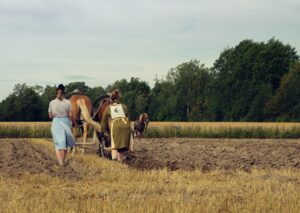Agricultural Tourism: Experiencing Farm Life in the Countryside


Agricultural tourism, also known as agritourism, is a unique form of travel that connects people to the countryside. It allows visitors to experience the daily life of farms, discover how food is grown, and participate in rural traditions. This type of travel is increasing in popularity because many people seek to escape busy cities and spend time in nature. Families, students, and travelers from around the world are exploring farms to relax, learn, and reconnect with the roots of food production.
What Makes Agricultural Tourism Unique
Agricultural tourism is not just about visiting a farm; it’s about experiencing the unique aspects of Farming. It is about experiencing the countryside. Visitors can walk through lush green fields, get up close to crops, and meet farmers who share their knowledge. Unlike traditional tourism, agritourism provides people with the opportunity to learn through hands-on experiences. Instead of watching from a distance, travelers can help milk a cow, pick fresh fruits, or even plant seeds.
One reason agricultural tourism is unique is the sense of authenticity. Farms are real places with real work happening every day. Guests witness the effort and care that goes into producing food. This differs from theme parks or resorts, where experiences are created for entertainment purposes. On a farm, what you see is the truth of rural life. That honesty attracts visitors who want more than just leisure—they want connection.
Activities in Agricultural Tourism
The activities in agricultural tourism are both fun and educational. Many farms open their gates for seasonal events, such as fruit picking, harvest festivals, and corn mazes. For example, apple orchards often invite families in the fall to pick apples straight from the trees. Vineyards may offer grape harvesting tours followed by wine tasting. These seasonal experiences help people appreciate the natural rhythm of the seasons.
Another activity is farm stays. Guests can spend a few days living on a farm, waking up to the sound of roosters and enjoying meals made from fresh, locally grown produce. Children especially love feeding animals like goats, chickens, or rabbits. They learn responsibility while also having fun. Some farms offer horseback riding, fishing, or wagon rides, making the stay even more exciting.
Workshops are also common in agricultural tourism. Farms may teach visitors how to make cheese, churn butter, or prepare jam from freshly picked berries. These hands-on lessons provide travelers with skills they can apply at home. Cooking classes that use farm ingredients are also popular. The activities change depending on the type of farm—dairy, crop, fruit orchard, or mixed farm.
Benefits for Travelers
Agricultural tourism provides many benefits for travelers. The first is relaxation. Far from the noise of cities, farms offer peace and fresh air. Visitors can slow down, breathe deeply, and take in the open landscapes. This helps reduce stress and improve mental well-being.
The second benefit is education. People learn where food comes from and how it reaches their plates. Children who see vegetables growing in soil develop a greater respect for Farming. Adults may discover traditional cultivation methods they were previously unaware of. This knowledge fosters awareness about food security and sustainable Farming practices.
Health is another benefit. Farm-fresh meals are healthier than processed food. Visitors often enjoy organic fruits, vegetables, and dairy products straight from the farm. This not only tastes better but also inspires people to eat more naturally at home.
Finally, agricultural tourism builds relationships. Travelers meet local farmers and connect with their stories. Sharing meals, working side by side, and exchanging ideas create bonds that last long after the trip ends. It is not just about seeing a place but also about knowing the people who live there.
Impact on Rural Communities
Agricultural tourism is also vital for rural communities. It provides farmers with an extra income. Farming alone can be unpredictable due to weather or market prices. By welcoming visitors, farmers create an additional source of revenue that helps them sustain their farms.
It also preserves rural traditions. When tourists show interest in old farming methods, crafts, and food recipes, these traditions gain value. Communities take pride in their culture and pass it on to younger generations. In this way, agricultural tourism protects heritage while also supporting modern needs.
Moreover, it creates jobs. Local guides, cooks, drivers, and artisans benefit from the presence of tourists. Small businesses, such as guesthouses, cafes, and craft shops, thrive around popular farm destinations. This growth reduces migration to cities because people find opportunities in their own villages.
Environmental awareness is another impact—many farms in agricultural tourism practice eco-friendly Farming to attract visitors who care about nature. Travelers learn about composting, rainwater harvesting, and organic Farming. This spreads sustainable practices beyond the countryside.
The Future of Agricultural Tourism
The future of agricultural tourism looks bright. Increasingly, people are seeking meaningful experiences over simple holidays. As cities grow faster and life becomes more stressful, the countryside offers a calm alternative. Schools and universities are also incorporating farm visits into their programs to educate students about agriculture.
Technology is also playing a role. Farms are promoting themselves online, sharing photos and booking systems to reach global travelers. Social media helps spread awareness of unique farm experiences, inspiring others to visit and explore these one-of-a-kind destinations. Virtual tours are even being used to attract visitors before they arrive in person.
Agricultural tourism can also contribute to supporting global food security. When travelers understand the challenges of Farming, they become more supportive of local farmers. They may choose to buy locally produced food, reduce waste, and advocate for policies that protect the agricultural sector. This awareness can shape healthier and more sustainable societies.
